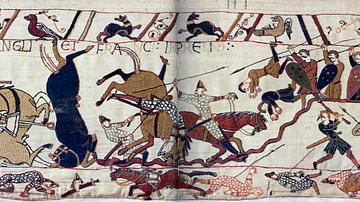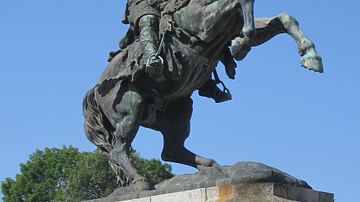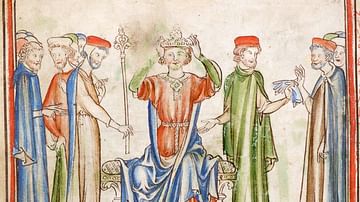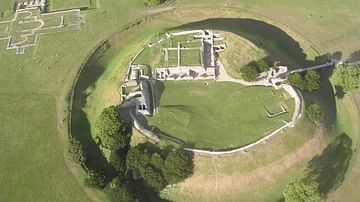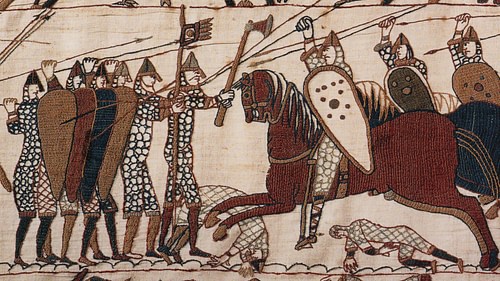
The Battle of Hastings in south-east England on 14 October 1066 saw the defeat of the Anglo-Saxon king Harold II (r. Jan-Oct 1066) by the invading Norman army led by William, Duke of Normandy (reigned from 1035). After a day of heavy fighting, the Norman cavalry eventually proved more effective than the Anglo-Saxon infantry.
William claimed the throne of England had been promised to him by Harold's predecessor, Edward the Confessor (r. 1042-1066) and he had invaded England to take by force the kingdom he considered rightfully his. Harold was killed in the battle, according to tradition, hit by an arrow to the eye and then hacked to pieces as he fell. The victor would be crowned king of England on Christmas Day of the same year and, over the next five years, his conquest of England would earn him the title of William the Conqueror. Hastings brought an end to 500 years of Anglo-Saxon rule and innumerable political, religious, and cultural changes over the coming decades as the Norman elite installed themselves throughout their new kingdom, setting up castles and creating such innovations as the Domesday Book.
Harold Godwinson
In 1066, the momentous year which would change English history, Harold Godwinson had only just become king of England. Formally the earl of Wessex, Harold was crowned on 6 January following the death of Edward the Confessor who had no heir. Harold had acquired the throne in unclear circumstances although Edward, on his deathbed, had personally nominated Harold as his successor. Harold was the foremost military leader in the kingdom and had built his reputation on his successful campaigns in Wales in 1063-4.
William, Duke of Normandy
Meanwhile, across the English Channel, William, the Duke of Normandy had other plans. William claimed that Edward had, in fact, promised him the throne back in 1051. The Norman also claimed that a visit by Harold in 1064 had either repeated Edward's offer or, thanks to the Norman securing the release of Harold after his capture by Count Guy of Ponthieu, the Englishman had promised William he would be his vassal and not obstruct his claim to the throne. This is the Norman view of the events leading up to 1066.
The Anglo-Saxon sources have an alternative version, well, actually three scenarios: Harold's trip to Normandy never took place, if it did it was merely an accident of the weather, or he merely went to Normandy in order to secure the release of some Anglo-Saxon prisoners. Finally, the English maintained after Hastings that even if the Normans were right and Harold had made such a promise of vassalage to William, it having been made while held captive made it invalid. The modern scholarly consensus is that William's claim to the English throne was a slight one but, as so often in history, such niceties as promises and oaths of loyalty meant very little compared to victory on the battlefield. Whatever William's self-justification might have been, he was intent on invading England and he made extensive preparations to do so in the summer of 1066.

Harald Hardrada & Tostig
As if the story of 1066 was not complicated enough, there was a third player in the deadly game for who would win the kingdom of England. King Harald Hardrada, aka Harald III of Norway (r. 1046-1066), had just as dubious a claim to Harold Godwinson's crown as William had but, like the Norman duke, he well knew that a strong army would more than make up for the flimsiness of his legal rights.
Hardrada was assisted by Tostig, the Earl of Northumbria, brother and great rival of Harold II. Tostig's harsh rule had caused a serious revolt in Northumbria in 1065, and he was consequently stripped of his title and banished out of harm's way to Flanders. Tostig did not take this treatment well, and his ships harried the southern and eastern coasts of England. Escaping to Scotland, Tostig eventually ended up in Norway, where he saw Hardrada as the ticket to wresting the throne from his brother.
Hardrada amassed an invasion fleet of perhaps around 300 ships, although some estimates go as high as 500. His army may have numbered around 12,000 warriors. Landing off the north-east coast of England near the mouth of the River Tyne on 8 September, Hardrada was there joined by a small fleet of perhaps 12 ships commanded by Tostig. From there the two fleets sailed south and eventually landed at Ricall, just 16 km (10 miles) from the key city of York. The threat to Harold Godwinson was self-evident but, timed as it was just when William was planning to invade in the south, the Anglo-Saxon king's crown was now in real danger.
Fulford Gate & Stamford Bridge
The first of the three major battles of 1066 was at Fulford Gate, an uncertain location somewhere near York. There, on 20 September, an Anglo-Saxon army led by Eadwine, earl of Mercia, and Morcar, the earl of Northumbria, clashed with Hardrada's army. The king of Norway was victorious but Harold was already on his way north with a second army which included his elite force of up to 3,000 housecarls (aka huscarls, professional armoured troops).
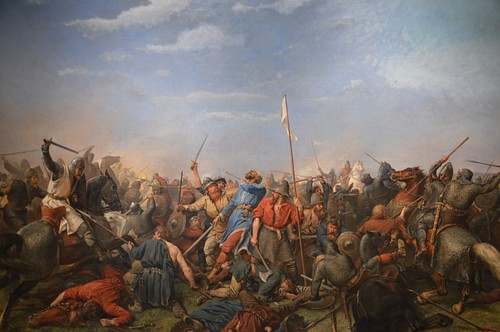
On 25 September Harold's army met Hardrada's force at Stamford Bridge, a wide meadow somewhere to the east of the River Derwent. Hardrada's men were caught by surprise as they were expecting that day to negotiate the release of hostages from York after the city's capitulation the day before. The invaders thus had the distinct disadvantage of being without their mail armour coats - they had left them in their camp following the victory celebrations after Fulford Gate. The fighting was over within a day, and both Hardrada and Tostig were killed. The battle was a complete victory for Harold, with the Anglo-Saxon Chronicle recording that there were only enough survivors from the invading army to fill 24 ships, which sailed back home under the command of Hardrada's son, Olaf. Harold had seen off one of the players for his crown but it was the more dangerous of his two rivals who now had to be faced in the south.
Invaders & Defenders
Throughout the summer William had been busy amassing a fleet on the northern coast of France near Saint-Valéry-sur-Somme. A contemporary Norman source puts the total number of ships at 776, but this is likely an exaggeration. The Norman warriors were motivated by the promise of booty and lands in the conquered territory but they were also paid by William during the summer preparation period. The total force is unknown, but most historians suggest a figure of 5-8,000 men, which included 1-2,000 cavalry.
Harold knew of the impending Norman invasion and had prepared to meet it, but he had trouble keeping his own force together. The English army had already been in the field for over three months, and by harvest time men had to return to their farms where everyone was needed to ensure there would be enough corn for the coming year. Bad weather stalled William's plans - or perhaps he was cannily waiting for his opponents to disband - and Harold returned to London in the first week of September. Then came news of Hardrada's invasion in the north and the defeat at Fulford Gate. Harold's march and victory at Stamford Bridge, although significant, was only the first act of a two-act tragedy for the English king.
On 28 September 1066, William and his invasion army landed at Pevensey in Sussex, southern England, where there was a good harbour and the added advantage of an old Roman fort which, refortified by William, provided some protection for the army's camp. The Normans would not have wondered where Harold was as they already had intelligence of Hardrada's invasion in the north. What William could not have known, though, was which king had won the Battle of Stamford Bridge and who his opponent might be. Then news came of Harold's victory and that he was marching south. Harold arrived in London on 6 October and mustered his army, gathering at Caldebec Hill, 13 km (8 miles) north of Hastings, on the 13th.
Harold's force included his elite housecarls and the general levy or fyrd, less well-trained troops supplied by each shire of the kingdom. Some sources, seeking to explain either the defeat or victory depending on the writer's loyalties, state that the Anglo-Saxon army was smaller than that of the Normans because Harold had not had time to muster troops from all of the shires. In contrast, other writers claim Harold's army was the bigger of the two. Given the closeness of the battle, though, it seems likely that both sides were more or less equal in size. One persistent criticism from medieval writers is that Harold mobilised too soon, perhaps deliberately enticed to do so by William's orders to ravage the territories of the south-east coast, Harold's personal estates.
Battle
The two armies met on 14 October 1066, William's force having advanced first to reach Harold's camp early in the morning. Harold's army, perhaps caught a little by surprise at the Normans' first move, took up position on a low rise, 'hammer-head ridge', which was protected on the sides by woods and in front by a stream and marshy ground. William's forces took up position to the south of the ridge in three infantry divisions: (from the left) Bretons, Normans, and French, all with a line of archers and a number of crossbowmen in front and the cavalry held in reserve at the rear.
Harold's warriors were typically armed with a sword, large axe, or long spear, and the better equipped (and front ranks) wore a chain mail coat. Further protection was provided by a conical helmet with a nose guard and a round or kite-shaped shield. There would have been some contingents of missile throwers who launched javelins, arrows, stone hammers, clubs, and slingshots at the enemy before the other warriors moved forward as a unit with shields held close together to create a 'shield-wall'. The next stage would have been more chaotic, with small fighting groups and duels predominating. A common tactic was to use pairs of soldiers, one wielding with both hands a broad-bladed axe and another soldier with a sword and shield with the job of protecting the axeman who could not carry a shield. The Normans, in contrast, favoured cavalry with armoured riders using close-order charges and lances braced under the arm to break up the enemy infantry formations. The Normans also had both bowmen and crossbowmen, something the Anglo-Saxon army probably lacked, at least in significant numbers.
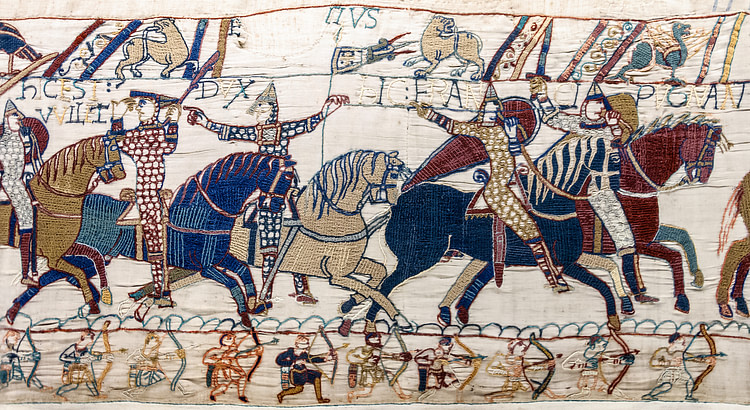
The Normans first launched a barrage of arrows, with the Anglo-Saxons responding by hurling a hail of stone axes at the enemy infantry as it tried to climb the ridge. The Norman cavalry was then sent in but was hampered by the terrain and slope so that they, too, were repelled by the Saxon shield wall. At one dramatic moment, a cry went up amongst the Normans that William had been struck down. This could have turned the battle as many an army in the Middle Ages had deserted the field once their commander had fallen. William, however, was unhurt, and he raised his visor and rode amongst his men to show that he was still alive and in command of the situation.
A number of the Anglo-Saxons, encouraged by the retreat of the Norman cavalry, then raced after them down the hill, but once on lower ground and losing their formation, they were cut down by the Norman horseman as they reverse-charged. Seeing the success of this, William ordered a further two feigned charges and retreats up to the ridge and back again, both times luring the enemy into a pursuit and ending in a successful counter-attack on flatter ground more suitable for the horses.
Death of King Harold
The fighting had now been raging for several hours, an unusually long time for a medieval battle. However, the superiority of the Norman cavalry against the Anglo-Saxon infantry was gradually winning the day, and now that their numbers were reduced, there were not enough Anglo-Saxons to defend the ridge. It was at this point that the depleted number of the best-trained troops, the housecarls (following the Battle at Stamford Bridge), must surely have been a telling factor. In a final cavalry charge, Harold and other Saxon leaders, including the king's brothers Gurth and Leofwine were killed. Harold's death, at least in tradition, was caused first by an arrow to the eye, then he was knocked over by a cavalry charge, and finally hacked to pieces by Norman swords as he lay prone on the ground. The remaining Anglo-Saxons fought a valiant rearguard action as they retreated to a nearby hill, the Malfosse, but they were eventually wiped out, and total victory was William's.
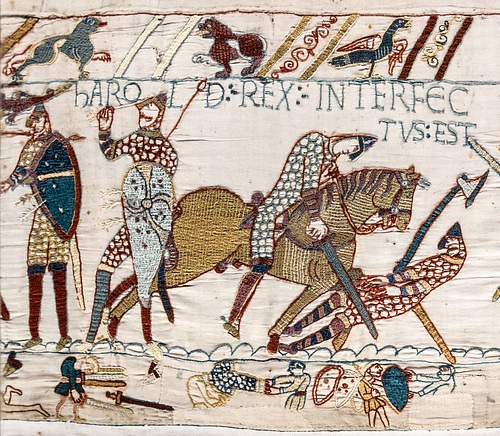
The Norman duke later built an abbey, known as Battle Abbey, on the site of the battle in thanks for his success, and its ruins still stand there today. The fate of Harold's body is unknown, although one 12th-century tradition states that his remains were removed from burial near the battlefield to Waltham Abbey - even if a later exploration of the tomb revealed that it was empty. There was also a legend that Harold had survived the battle and lived into old age but such stories and the mystery of the fallen king's burial are probably exactly what William wished: there would be no king's burial and no martyr's grave for rebels to rally around.
Aftermath
William the Conqueror, as he became known, was crowned William I, king of England on Christmas Day of the same year at Westminster Abbey, bringing an end to 500 years of Saxon rule. William, though, did have to struggle for five more years - winning battles against rebels in the north of England and building Norman motte and bailey castles everywhere - before he completely controlled his new realm.
One of the great records of the Battle of Hastings is the Bayeux Tapestry. Produced between 1067 and 1079, the tapestry measures around 68 metres by 50 cm and depicts in detail many aspects of the Norman Conquest and the events leading up to it, but it is a propaganda piece, reinforcing William's claim to the English throne and, for example, omitting the Battle of Stamford Bridge. Nevertheless, the images on the tapestry (actually an embroidery) are striking, particularly of the Battle of Hastings and the death of Harold.
The demise of both the Anglo-Saxons and the Vikings in the battles of 1066 ushered in a new era of history in northern Europe and England, in particular, where the Normans replaced the Anglo-Saxon ruling elite, the Church was similarly restructured, and much closer ties with continental Europe were established, especially with France, something which would have a tremendous bearing on the history of the two countries over the following centuries.
